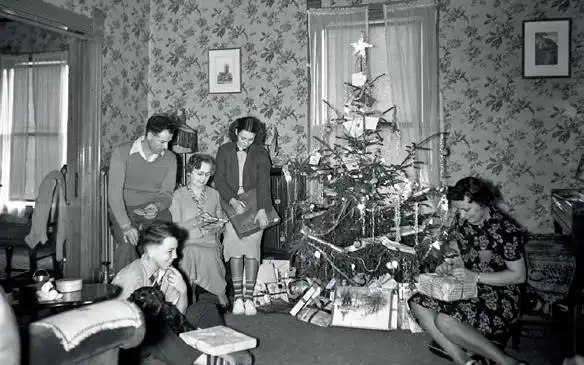
4 minute read
History
Step into a 1940s Christmas
There is no doubt that Christmas is more commercialised than ever before. Could we learn a thing or two from our parents and grandparents about enjoying the festive season without breaking the bank?
Advertisement

In the early 1940s, Britain was of course in the midst of World War II. From food to gifts, people had to be creative as they planned their festivities. Encouraged to grow and rear their own food wherever possible and ‘dig on for victory’, people became accustomed to food rationing and to making do with what they had. The main Christmas meal would likely have featured a roast chicken or, for those better off , perhaps goose, lamb or pork – whatever the choice of meat, there would have been a side of home-grown vegetables from the ‘dig on’ eff orts. Dried fruit was less plentiful, so breadcrumbs and grated carrot were added to Christmas puddings and cakes as a way of bulking them out. Rations would be saved up in the weeks leading up to Christmas in preparation for the big day, whilst some items (such as tea and sugar) were available in larger quantities at Christmas to help people celebrate the season. The blitz and the resulting blackout meant that there were no lights on the streets to add a touch of seasonal sparkle. Of course, this didn’t stop people from fi nding ways to brighten their homes with festive touches; winter
foliage and homemade paper chains were both used as decorations. Even with the scarcity of paper, there were ways to make such decorations, including painting strips of old newspaper and looping them together. Pre-war decorations such as glass baubles were also used to add some festive cheer; reusing and recycling what you already had were part of daily life. Gifts were given wrapped in brown paper, newspaper or even pieces of fabric – to use gift wrap would have been wasteful in a time when paper was scarce. The gifts themselves were often homemade – knitted scarves, gloves and hats made excellent gifts and, to avoid wastage, they could even be made using wool from old clothes. An outgrown “ Gifts were given wrapped in brown paper, newspaper or even pieces of fabric – to use gift wrap jumper could be unravelled and the wool used again; people were both skilled and savvy. Food gifts were of course also would have been wasteful. ” very welcome at such a time of frugality, so homemade jams and chutneys were popular presents. During the war years, the royal speech became a British Christmas tradition. The wireless provided entertainment, as did the singing of carols and the joy of family games. With many away fi ghting or supporting

the war eff ort, and a great number of children spending Christmases as evacuees, those who were together for Christmas were reminded that they were fortunate to be in one another’s company. Presence was no doubt appreciated far more than presents. As we plan for Christmas 2022 amidst the pressures
of the current cost of living crisis, there is plenty we can learn from Christmases and generations gone by. A happy festive season is not measured by its monetary value. Take some time out to enjoy the simple things this season if you can. Make paper chains, design Christmas cards, attend a carol service… Try to fi nd the time to enjoy festivities with those you love. In our family, we have always shared with our children that gifts from Santa equate to elf hours. If an item is expensive to buy from a shop, then you can be sure it takes a lot of elf hours to create in the workshop! There are only a certain number of elf hours to share amongst all the children in the world, so our expectations need to be reasonable. The same
is true when gifting to each other; giving means thinking of another person, taking time to choose or craft something in order to spread joy. That’s a gift in itself. Your time, your care and your presence will always be the most precious presents you can give – something that remains unchanged since the Christmases of the 1940s. n Joanne Mallard L



February 24th-26th 2023
Ivybridge eatre Company presents











